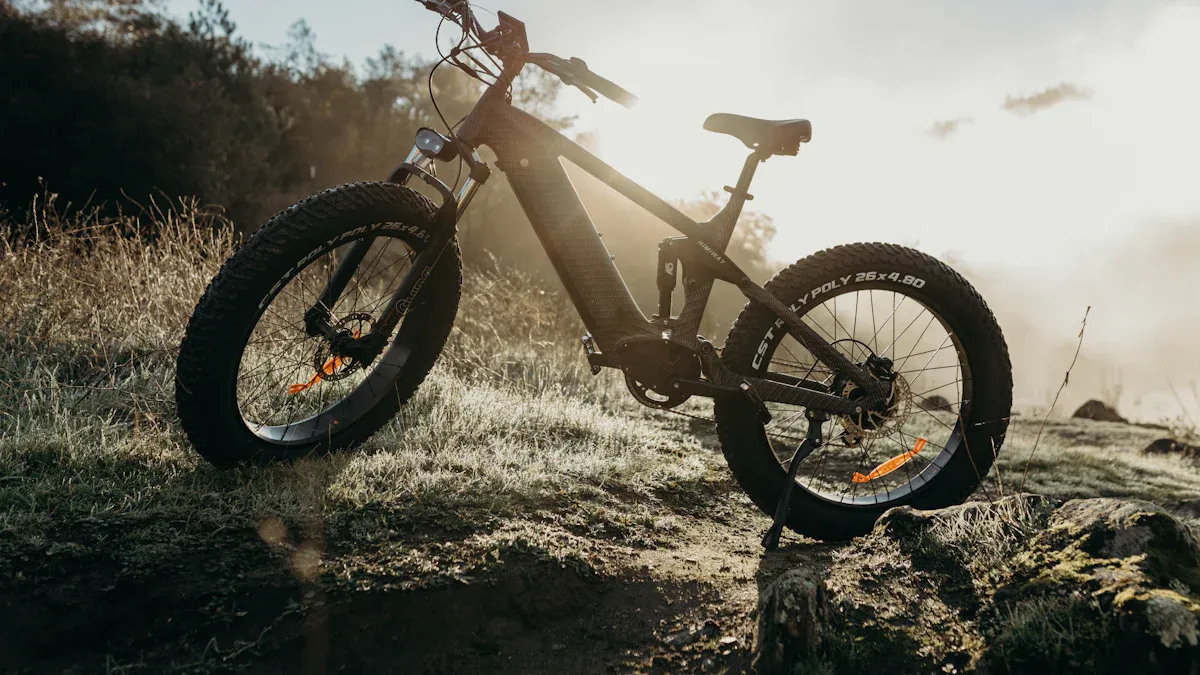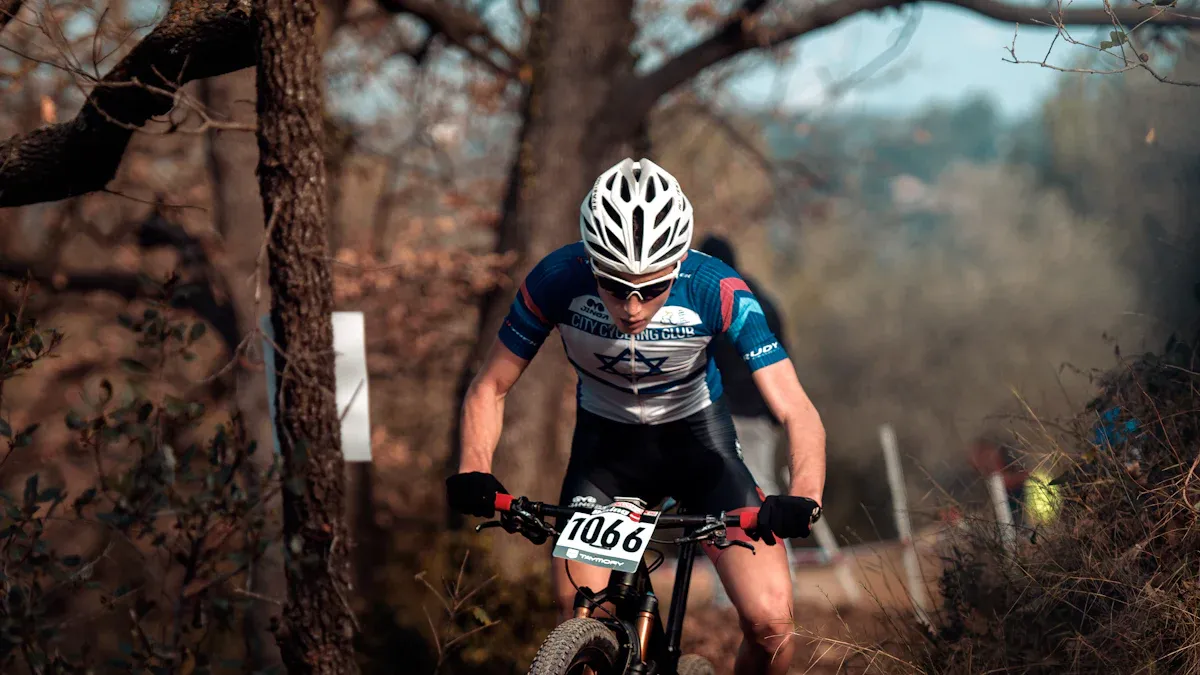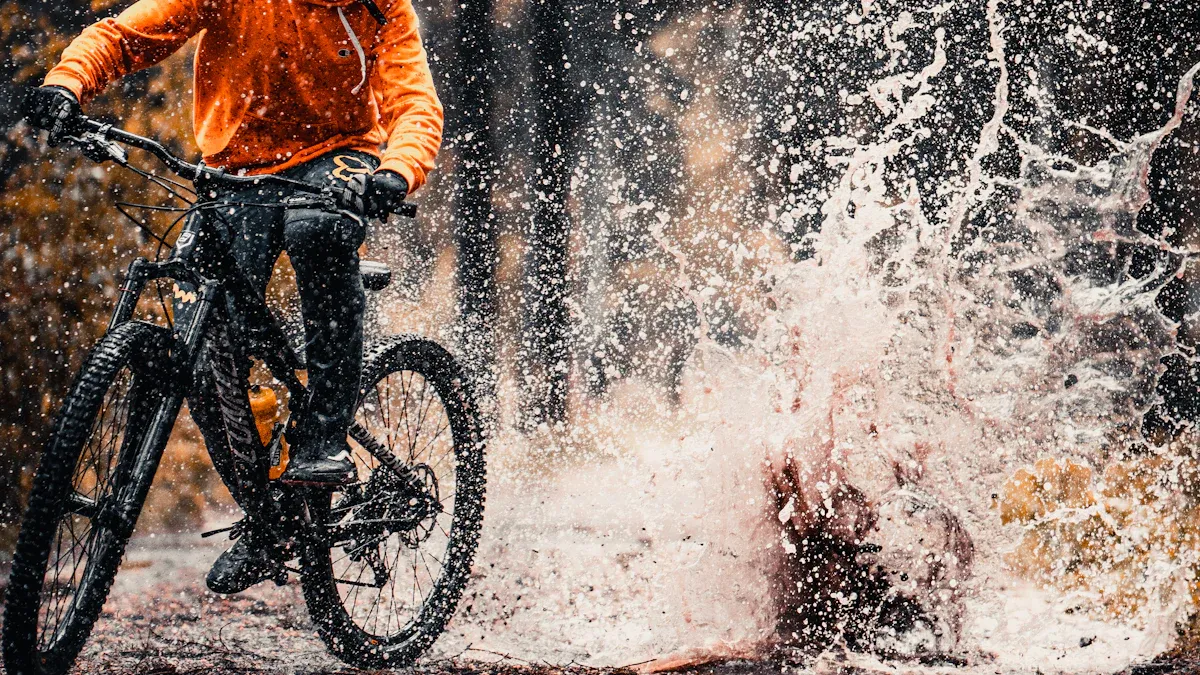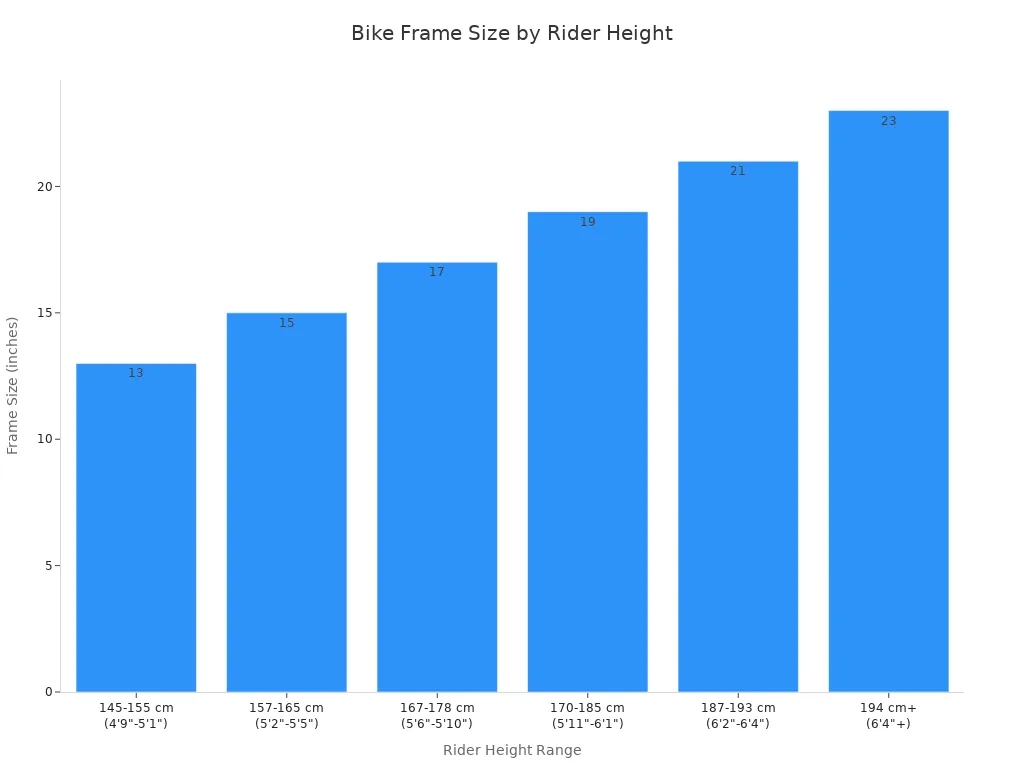
You might be surprised at how much fun you can have on a small frame mountain bike. Riders say these bikes give you quick handling and a lively feeling on the trail.
You get sharper cornering and better control, especially in tight spots.
Many riders love the playful ride and easy jumps.
Some say bigger frames feel stable but lose excitement and responsiveness.
Real stories show that switching to a smaller frame can make your rides feel fresh and full of energy.
Key Takeaways
Small frame mountain bikes turn fast and feel fun to ride. Many riders like them on tricky trails. Picking the right frame size makes you more comfortable. It also helps you get less tired and control the bike better. You can change the seat height, stem length, and handlebar spot. This helps a small frame fit people of different heights. Small frames are great for sharp turns, jumps, and going uphill. They work well for both new and skilled riders. Always try the bike and check the fit before you buy. This keeps you safe, comfy, and gives you the best ride.
Rider Stories

Backgrounds
You might think only shorter riders look for a small frame mountain bike, but the real stories show a mix of backgrounds. Some riders stand just over five feet tall and struggle to find bikes that fit. Others are taller but want a different ride feel. You may even see experienced mountain bikers and beginners both choosing smaller frames for their own reasons.
Take Mia, who is 5’2″. She always felt stretched out on standard bikes. After switching, she said,
“I finally feel like the bike fits me. My arms and back don’t hurt after long rides anymore.”
Then there’s Alex, who is 5’8″. He tried a small frame mountain bike because he wanted something more playful for local trails. He found the smaller size made it easier to pop over roots and rocks. Riders like Mia and Alex show that height is just one part of the story.
Choosing Small Frames
Why do so many riders pick a small frame mountain bike? The reasons might surprise you:
You get a more relaxed and comfortable riding position.
The bike feels nimble and responds quickly when you turn.
If you have long legs or less flexibility, a smaller frame can help you sit more upright.
The shorter reach means you don’t have to stretch as far to grab the handlebars.
A shorter wheelbase gives you a zippy, agile ride.
Many beginners and intermediate riders say they feel more confident and in control.
You might notice that professional riders sometimes pick smaller frames, too. They want a lower front end for better control and a lighter, stiffer bike. For most people, the choice comes down to comfort, riding style, and the type of trails you love. If you want a bike that feels lively and easy to handle, a small frame could be the perfect fit.
Fit and Comfort
For Shorter Riders
If you are a shorter rider, you know how tough it can be to find a bike that feels right. Many riders around 5’1″ say that extra small frames fit them best. You get a bike that matches your height, so you do not feel stretched out or cramped. Smaller wheels, like 26″ or 27.5″, make the bike easier to control and more fun to ride. You can handle tight turns and technical trails with confidence.
“I’m 5’1″ and always felt awkward on bigger bikes. My small frame mountain bike with 27.5″ wheels finally feels like it was made for me. I can reach the handlebars and stand over the frame without any trouble.”
A rider at 5’4″ shared that medium frames felt too big and heavy. When they switched to a small frame, they felt more in control and enjoyed riding more. You might notice less fatigue because the bike fits your body better. Your arms and back do not get sore as quickly, and you can ride longer without discomfort.
For Taller Riders
You might think small frames are only for shorter people, but that is not always true. Some taller riders, even those around 5’8″ to 5’10”, choose small frames for a more playful ride. You get a nimble bike that responds quickly, especially if you like technical trails or jumps. One rider at 6’4″ even managed to ride a short frame comfortably by making smart adjustments.
“I’m 5’9″ and tried a small frame for fun. It felt lively and easy to throw around on the trail. I just had to tweak the seat and handlebars a bit.”
You may enjoy the stiffer feel of a small frame, which helps with power transfer and climbing. The bike can feel more responsive, but you need to watch out for cramped positions. If the frame is too small, you might feel hunched over or get tired faster. Some riders prefer longer frames for stability, so it depends on your style and what feels best for you.
Adjustments
Getting the right fit is key, no matter your height. You can make several adjustments to improve comfort on a small frame mountain bike:
Raise the seatpost for proper leg extension. Sometimes you need a longer seatpost.
Use a seatpost with setback to move the saddle back, lining up your body over the pedals.
Change the stem length to adjust how far you reach for the handlebars.
Adjust the stem angle to lift the handlebars higher.
Fine-tune the saddle angle and position for better comfort.
Here’s a quick table to show common adjustments and what they help with:
Adjustment | What It Helps With |
|---|---|
Seatpost Height | Leg extension, knee comfort |
Seatpost Setback | Pedal alignment, posture |
Stem Length | Reach, upper body comfort |
Stem Angle | Handlebar height, neck pain |
Saddle Position | Back and hip comfort |
You need to be careful with extreme changes. If you raise the saddle too much or stretch the handlebars too far, you can get neck, back, or knee pain. Sometimes, a frame that is too small can cause hand numbness or make you feel unstable on rough trails. Always test ride and adjust slowly to find what works for you.
Tip: If you feel pain or discomfort, stop and check your bike fit. Small changes can make a big difference.
You want a bike that fits your body and riding style. When you get it right, you will notice less fatigue, better posture, and more fun on every ride.
Handling and Performance

Maneuverability
You want a bike that feels quick and easy to control, especially when the trail gets twisty. Small frame mountain bikes shine here. Their shorter wheelbase and lighter weight let you make sharp turns and sudden moves without much effort. You can dodge rocks, weave through trees, and handle tight switchbacks with confidence.
“My small frame bike lets me change direction in a snap. I feel like I can dance through the woods instead of fighting the bike.”
When you ride a smaller frame, you notice the bike reacts faster to your movements. You have to stay focused because the balance point is smaller, but this makes the ride more exciting. Larger frames feel steadier at high speeds, but they can seem slow and heavy when you need to make quick moves.
Here’s a quick look at how smaller and larger frames compare:
Smaller MTB Frame Advantages | Larger MTB Frame Advantages |
|---|---|
Better in slow and tight turns | Better in fast, straight sections |
Easier to pop manuals and jib | More stable on big jumps |
More playful on technical trails | More stable on rough descents |
Better for quick, sudden maneuvers | Easier to hold a line at speed |
If you love technical trails or want to try new tricks, a small frame mountain bike gives you the edge.
Climbing and Descending
Climbing can feel easier on a small frame. The bike’s lighter weight and shorter reach help you move your body into the best position. You can shift your weight forward for steep climbs and keep your front wheel planted. Many riders say they feel more in control and can react faster to changes in the trail.
On the way down, you might notice the bike feels lively and quick. You can pick your line and make fast corrections if you hit a root or rock. Some riders say small frames feel “twitchy” at high speeds or on big jumps, but you gain a lot of control in tight spots.
Performance Aspect | Small Frame Mountain Bikes | Standard/Larger Frame Mountain Bikes |
|---|---|---|
Maneuverability | More playful, better for tight turns | More stable, better for fast sections |
Technical Trail Handling | Great for manuals, jibs, and ledges | Better for rough rock gardens and big jumps |
Climbing | Feels easier, more aggressive position | Less focus on climbing advantage |
Descending | Quick and lively, less stable at high speed | Very stable at high speed, good for parks |
General Use | Best for technical and unknown trails | Best for gravity and downhill trails |
Modern mountain bike geometry also plays a big role. Bike makers adjust things like head angle and reach to help small frames handle better. Sometimes, they use different fork offsets to keep steering quick and stable. You get a bike that fits your body and still feels great on the trail.
Playfulness
If you want a bike that feels fun and playful, a small frame mountain bike is hard to beat. The shorter wheelbase and lighter build make it easy to pop over roots, jump off ledges, and try new tricks. You can flick the bike around and feel like you are part of the trail.
You get more agility and faster response.
It’s easier to lift the front wheel or hop over obstacles.
The bike feels lighter and more “flickable” on every ride.
Professional riders often choose smaller or medium frames for technical trails. They like the extra control and the ability to make quick moves. On tight, twisty trails, you can pick your line and change direction fast. If you ride smoother trails or want to practice skills, a small frame helps you learn and have more fun.
Tip: If you want to boost your confidence and try new moves, a small frame mountain bike can make every ride feel like an adventure.
Small Frame Mountain Bike Tips
Sizing and Safety
Getting the right size matters most for comfort and safety. You want a bike that fits your height and matches your riding style. If you pick a frame that is too big, you might feel awkward and lose control. A frame that is too small can be adjusted, but you still need enough room to move and stand over the bike safely.
Check out this chart to see which frame size fits your height:
Rider Height Range (cm/ft) | Recommended Frame Size (inches) | Alpha Size |
|---|---|---|
145-155 cm (4’9″-5’1″) | 13-14″ | XS |
157-165 cm (5’2″-5’5″) | 15-16″ | S |
167-178 cm (5’6″-5’10”) | 17-18″ | M |
170-185 cm (5’11”-6’1″) | 19-20″ | L |
187-193 cm (6’2″-6’4″) | 21-22″ | XL |
194 cm+ (6’4″+) | 23″ | XXL |

You should also look for at least 2 inches of clearance when you stand over the top tube. This helps you get on and off the bike without trouble. If you feel cramped or stretched out, you may need a different size. Remember, comfort leads to better control and safer rides.
Tip: Always start with your height, but think about your skill level and riding style too. A small frame mountain bike often feels easier to handle for beginners.
Component Adjustments
Once you have the right frame, you can fine-tune the fit with simple adjustments. You can change the handlebars, stem, and seat to match your body and riding style.
Component | Adjustment Details and Effects |
|---|---|
Handlebars | Set height about 2 inches lower than saddle for balance. Use spacers to raise or lower. Rotate riser bars for climbing or upright position. Adjust brake levers for wrist comfort. Pick width that matches your shoulders. |
Stem | Shorter stem gives upright position. Longer stem stretches you forward. Flip stem angle to change handlebar height. |
Seat | Adjust height for slight knee bend at bottom of pedal stroke. Move seat forward or back for comfort. Tilt nose up or down based on handlebar height. Pick seat width for your anatomy. |
If you set the handlebars too low, you might get neck pain. If they are too high, you could lose control on steep trails. Always check your saddle height and foot position. A good fit helps you ride longer and avoid injury.
Note: Small changes make a big difference. Try adjusting one part at a time and see how it feels.
Test Riding
You should always test ride before you buy. Riding different sizes helps you find what feels best. Specs and charts give you a starting point, but only a real ride shows how the bike fits your body.
Many riders regret buying a bike without trying it first. You might find that a small frame mountain bike feels perfect, or you may need a medium for more stability. Professional bike fitting can help you dial in the details, like saddle height and handlebar reach.
Try several bikes on the same trail if you can.
Pay attention to comfort, control, and how easy it is to steer.
Ask for help from a shop or fitter if you feel unsure.
🚲 Tip: The right fit boosts your confidence and makes every ride safer and more fun.
You discover surprising benefits when you choose a bike that fits you well. Riders say small frames boost comfort, agility, and control, especially on rough terrain or city streets.
You get easier handling, playful rides, and less fatigue.
Adjustments help, but picking the right size matters most for safety and fun.
Share your story in a friendly online group. Post photos or videos and inspire others to try new adventures. Why not test a new ride and see what you love?
FAQ
Can a small frame mountain bike handle rough trails?
You can ride a small frame on rough trails. Many riders say these bikes feel nimble and easy to control. You may need to adjust your setup for extra comfort. Always check your fit before tackling rocky or steep terrain.
Will a small frame mountain bike fit me if I am tall?
You might fit a small frame even if you are tall, but you need to test it first. Try raising the seat and adjusting the handlebars. If you feel cramped or uncomfortable, you may want a bigger frame.
Are small frame mountain bikes good for beginners?
Yes! Small frames often feel easier to handle for new riders. You get better control and confidence on tight trails. Many beginners say they learn skills faster on a smaller bike.
What should I check before buying a small frame mountain bike?
Stand over the bike to check clearance.
Test ride for comfort and control.
Adjust the seat and handlebars.
Tip: If you feel pain or numbness, try a different size or make more adjustments.
Can I use a small frame mountain bike for jumps and tricks?
You can! Many riders love small frames for jumps and playful riding. The bike feels light and easy to move. Just make sure your fit is right so you stay safe and have fun.
See Also
Professional Tips For Selecting The Perfect Carbon Bike Frame
How To Easily Determine Your Best Downhill Bike Frame Size
The Importance Of Picking The Correct Bike Frame Geometry
Understanding The Science That Drives Mountain Bike Frame Flexibility
A Clear Guide To Large Mountain Bike Frame Sizes And Geometry
